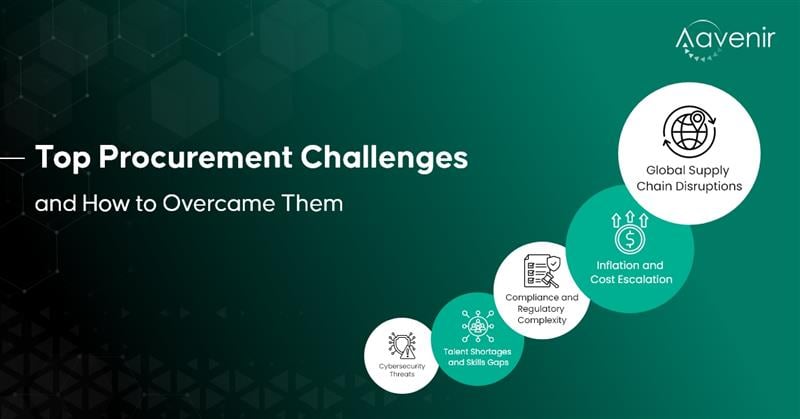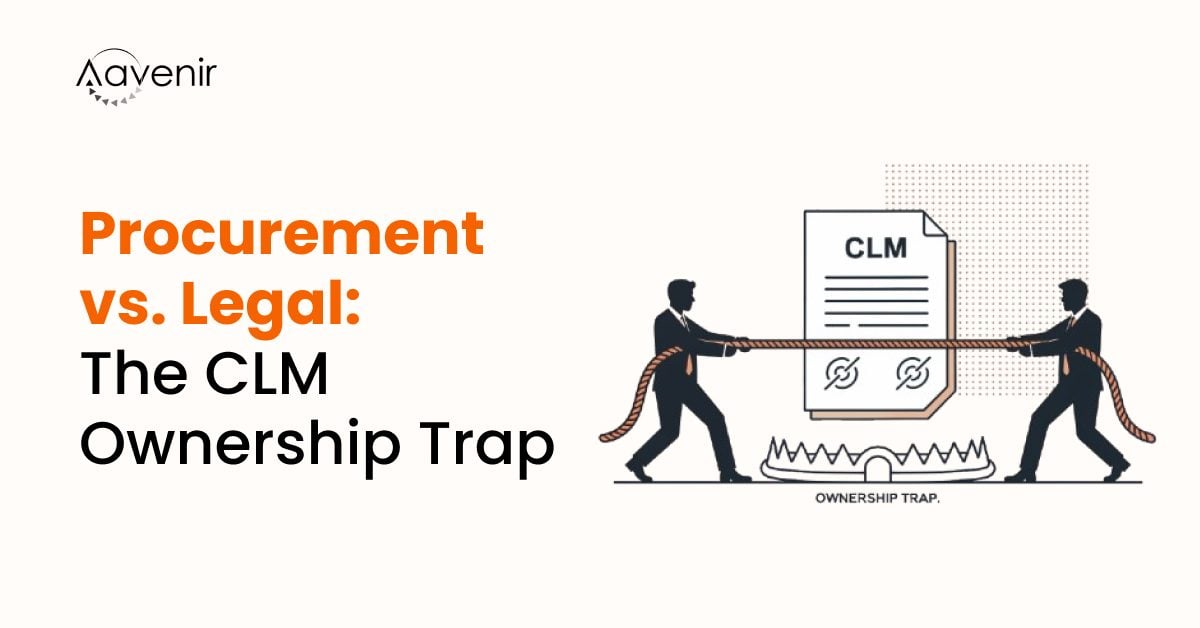In 2025, procurement leaders are navigating a rapidly evolving landscape marked by the need to balance cost-efficiency, compliance, and risk management with increasing demands for digital innovation and sustainability.
As key drivers of organizational value, procurement teams play a critical role in managing resources, mitigating risks, and implementing technology-driven efficiencies that streamline the source-to-pay process.
To succeed, procurement professionals must embrace agility and resilience, especially as sectors such as manufacturing, healthcare, higher education, and BFSI (Banking, Financial Services, and Insurance) grapple with unique challenges that demand innovative procurement strategies.
Such a dynamic environment underscores the necessity for businesses to adopt technology-enabled solutions like AI and predictive analytics, diversify supplier bases, and integrate sustainable practices. By doing so, organizations can remain competitive while addressing global trade disruptions, economic pressures, and evolving regulatory landscapes.
This blog explores the most pressing procurement challenges of 2025, providing actionable insights and solutions for CPOs and procurement professionals striving to thrive in this complex and transformative era.
Challenges in Procurement Process 2025
Global economic shifts, technological advancements, and increased regulatory pressures are reshaping the procurement landscape in 2025. Here, we cover some of the most pressing challenges procurement teams face and explore practical solutions.
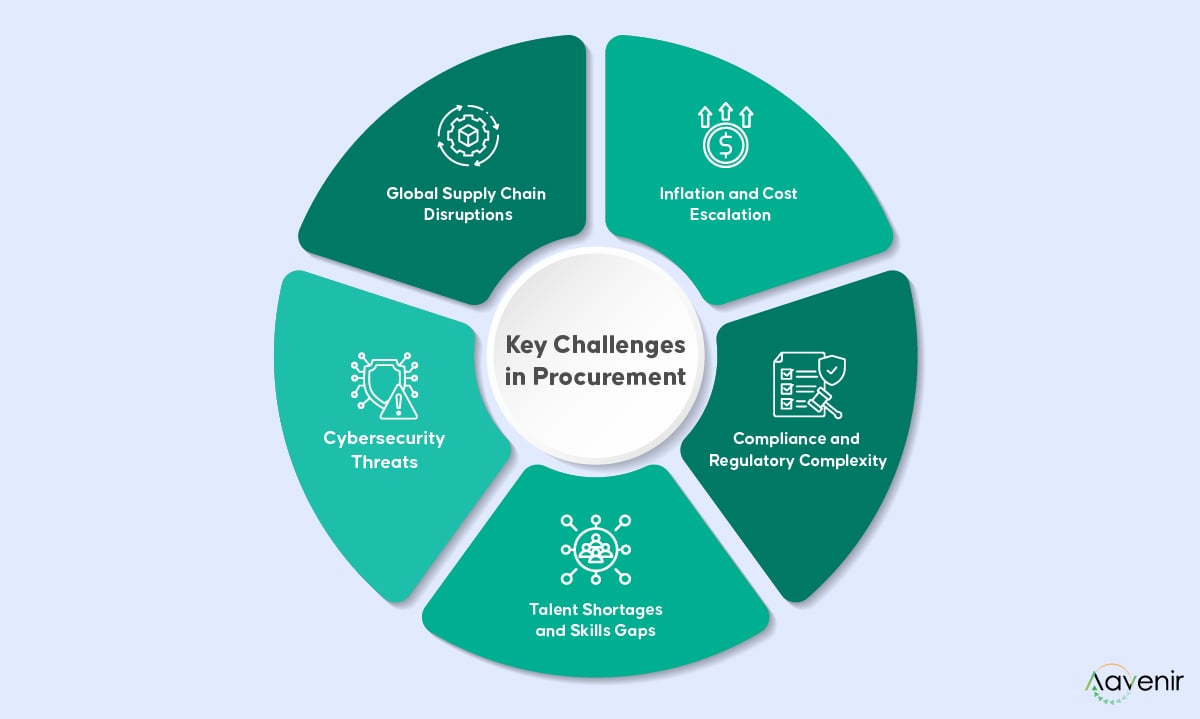
5 Key Challenges in Procurement
Global Supply Chain Disruptions
Global supply chain disruptions continue to be a significant challenge. Natural disasters, geopolitical tensions, and pandemics can all cause severe disruptions. According to recent findings by the World Economic Forum, organizations that invested in supply chain resilience reported 20-30% fewer disruptions than those that didn’t—a testament to the importance of proactive measures. To manage these dependencies and ensure continuity, procurement teams should:
- Diversify Suppliers: Avoid relying on a single supplier or region. Diversifying your supplier base can mitigate risks. For example, during the COVID-19 pandemic, companies with a diversified supplier network were better able to manage disruptions than those relying on a single source.
- Implement Resilience Measures: Develop contingency plans and maintain safety stock to buffer against disruptions. This includes identifying critical suppliers and creating backup plans. For instance, some companies have started using dual-sourcing strategies to ensure they have alternative suppliers in case of disruptions.
- Leverage Technology: Use predictive analytics to anticipate disruptions and plan accordingly. Advanced analytics can help identify potential risks in the supply chain and allow procurement teams to take proactive measures. For example, machine learning algorithms can analyze historical data to predict future disruptions and suggest mitigation strategies.
Inflation and Cost Escalation
Inflation and rising costs are pressing concerns for procurement professionals. Deloitte’s recent survey showed that 67% of CPOs ranked cost management as their number one focus. To tackle these issues, businesses can have:
- Flexible Contracts: Negotiate contracts that allow for price adjustments based on market conditions. This can include clauses that account for inflation or other economic factors. For example, some companies use index-based pricing, where the price of goods is tied to a specific index, allowing for adjustments based on market fluctuations.
- Predictive Analytics: Utilize data to forecast price trends and allocate budgets more effectively. Predictive analytics can help procurement teams anticipate cost increases and adjust their strategies accordingly. For instance, by analyzing market trends, companies can make informed decisions about when to buy in bulk to take advantage of lower prices.
- Cost Optimization: Continuously seek cost-saving opportunities through strategic sourcing and process improvements. This can include renegotiating contracts, consolidating suppliers, and optimizing procurement processes. For example, some companies have implemented lean procurement practices to reduce waste and improve efficiency.
Compliance and Regulatory Complexity
Navigating the ever-changing regulatory landscape is a daunting task. To stay compliant:
- Establish Compliance Teams: Dedicated teams can monitor regulatory changes and ensure adherence. These teams can also provide training and support to other departments. For example, a compliance team can help ensure that all procurement activities meet local and international regulations.
- Leverage Compliance Software: Use software solutions to track and manage compliance requirements. These tools can automate compliance monitoring and reporting, reducing non-compliance risk. For instance, some companies use compliance management systems to track regulatory changes and ensure that all procurement activities comply.
- Train Regularly: Keep your team updated with regular training on new regulations and compliance practices. This can include workshops, webinars, and online courses. For example, regular training sessions can help procurement professionals stay informed about new regulations and best practices.
Talent Shortages and Skills Gaps
The procurement sector is facing a talent crunch. To attract and retain skilled professionals, organizations can offer:
- Competitive Benefits: Offer attractive compensation packages and benefits. This can include competitive salaries, bonuses, and other incentives. For example, some companies offer flexible working arrangements and professional development opportunities to attract top talent.
- Training Programs: Invest in continuous learning and development programs to upskill your team. This can include on-the-job training, mentorship programs, and external courses. For instance, some companies partner with universities and training providers to offer specialized procurement courses.
- Employer Branding: Build a strong employer brand to attract top talent, including promoting your company’s culture, values, and achievements. For example, showcasing employee testimonials and success stories can help attract skilled professionals to your organization.
Cybersecurity Threats in Procurement
With the increasing digitization of procurement processes, cybersecurity threats are on the rise. According to IBM’s 2024 Cybersecurity Trends report, 45% of procurement professionals cited data security as a top concern. For the safeguarding of procurement data, businesses should implement:
- Multi-Factor Authentication:Implement robust authentication methods to protect sensitive information. This can include using two-factor authentication (2FA) and biometric verification. For example, requiring employees to use a combination of passwords and fingerprint scans can enhance security.
- Employee Training: Regularly train employees in cybersecurity best practices. This can include phishing awareness training and secure password practices. For instance, conducting regular cybersecurity workshops can help employees recognize and avoid potential threats.
- Advanced Security Solutions: Invest in advanced cybersecurity solutions to detect and prevent threats. This can include firewalls, intrusion detection systems, and encryption technologies. For example, using end-to-end encryption can protect sensitive procurement data from unauthorized access.
3 Direct Procurement Challenges in 2025
Direct procurement involves sourcing raw materials and components directly related to production. Key challenges include:
Supplier Management
Maintain strong relationships with suppliers to ensure quality and reliability. This can include regular communication, performance reviews, and collaborative planning. For example, conducting quarterly business reviews with key suppliers can help address issues and improve performance.
Cost Optimization
Continuously seek ways to reduce costs without compromising quality. This can include negotiating better terms, bulk purchasing, and process improvements. For instance, implementing just-in-time (JIT) inventory management can reduce holding costs and improve efficiency.
Inventory Control
Implement effective inventory management strategies to adapt to market volatility. This can include using inventory management software and adopting lean inventory practices. For example, using real-time inventory tracking can help optimize stock levels and reduce the risk of stockouts.
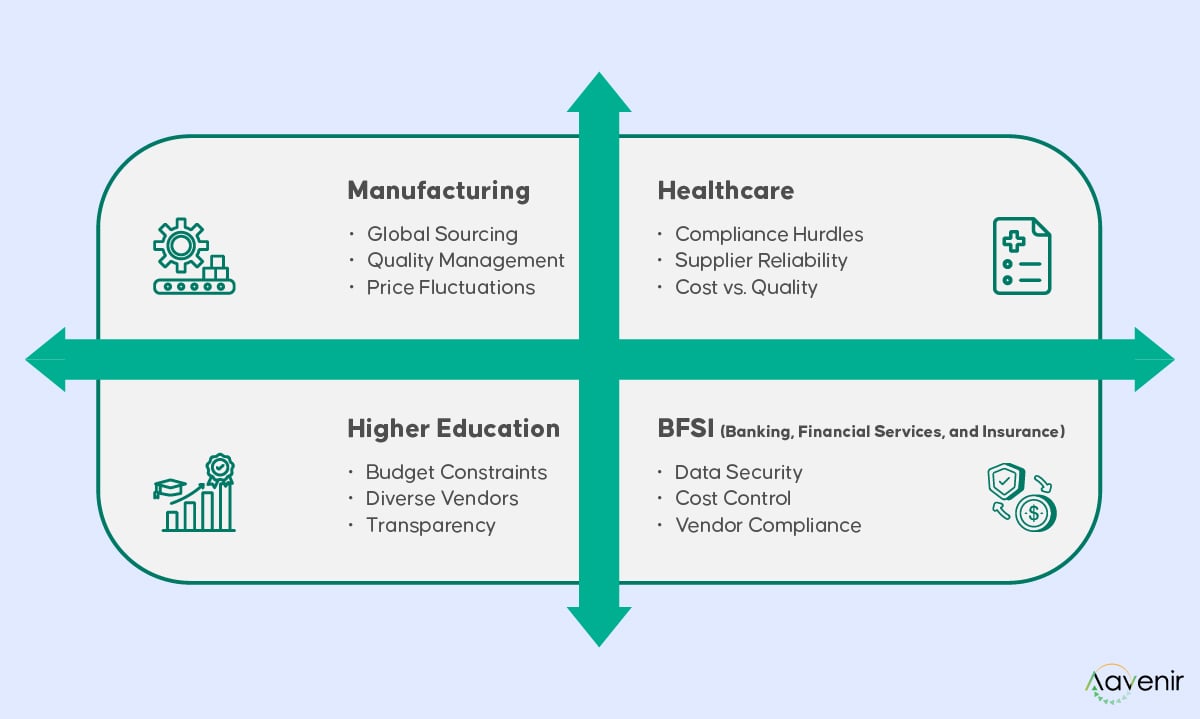
4 Industry-Specific Procurement Challenges in 2025
Manufacturing
Manufacturing procurement faces unique challenges such as:
- Global Sourcing: Manage suppliers across different regions and ensure timely delivery. This can include dealing with different time zones, languages, and cultural differences. For example, using a global procurement platform can help streamline communication and coordination with international suppliers.
- Quality Management: Ensuring the quality of raw materials and components. This can include implementing quality control processes and conducting regular audits. For instance, using statistical process control (SPC) can help monitor and improve product quality.
- Price Fluctuations: Handling fluctuations in raw material prices. This can include using hedging strategies and long-term contracts to manage price volatility. For example, some companies use commodity futures contracts to lock in prices and reduce the impact of price fluctuations.
Healthcare
Healthcare procurement is critical due to the nature of the industry. Challenges include:
- Compliance Hurdles: Navigating stringent regulatory requirements. This can include ensuring that all medical supplies meet regulatory standards and obtaining necessary certifications. For example, using a compliance management system can help track and manage regulatory requirements.
- Supplier Reliability: Ensuring the reliability of suppliers for critical medical supplies. This can include conducting thorough supplier evaluations and maintaining backup suppliers. For instance, using a supplier scorecard can help assess and monitor supplier performance.
- Cost vs. Quality: Balancing cost with the quality of medical supplies. This can include negotiating better terms and using value-based procurement strategies. For example, using total cost of ownership (TCO) analysis can help evaluate the long-term value of medical supplies.
Higher Education
Procurement challenges in higher education involves:
- Budget Constraints: Managing procurement within tight budgets. This can include prioritizing spending and seeking cost-saving opportunities. For example, cooperative purchasing agreements can help achieve economies of scale and reduce costs.
- Diverse Vendors: Ensuring a diverse vendor base to meet various needs. This can include promoting supplier diversity and using inclusive procurement practices. For instance, implementing a supplier diversity program can help identify and engage diverse suppliers.
- Transparency: Maintaining transparency in procurement processes. This can include using procurement software to track and report on procurement activities. For example, using an e-procurement system can help ensure transparency and accountability in procurement processes.
BFSI (Banking, Financial Services, and Insurance)
Procurement in BFSI sectors faces challenges such as:
- Data Security: Ensuring the security of sensitive financial data. This can include using encryption and secure data storage solutions. For example, using blockchain technology can enhance data security and integrity.
- Cost Control: Managing costs while ensuring quality. This can include using cost-saving strategies and negotiating better terms with suppliers. For instance, using spend analysis can help identify cost-saving opportunities and optimize procurement processes.
- Vendor Compliance: Ensuring vendors comply with industry regulations. This can include conducting regular audits and using compliance management software. For example, using a vendor management system can help track and manage vendor compliance.
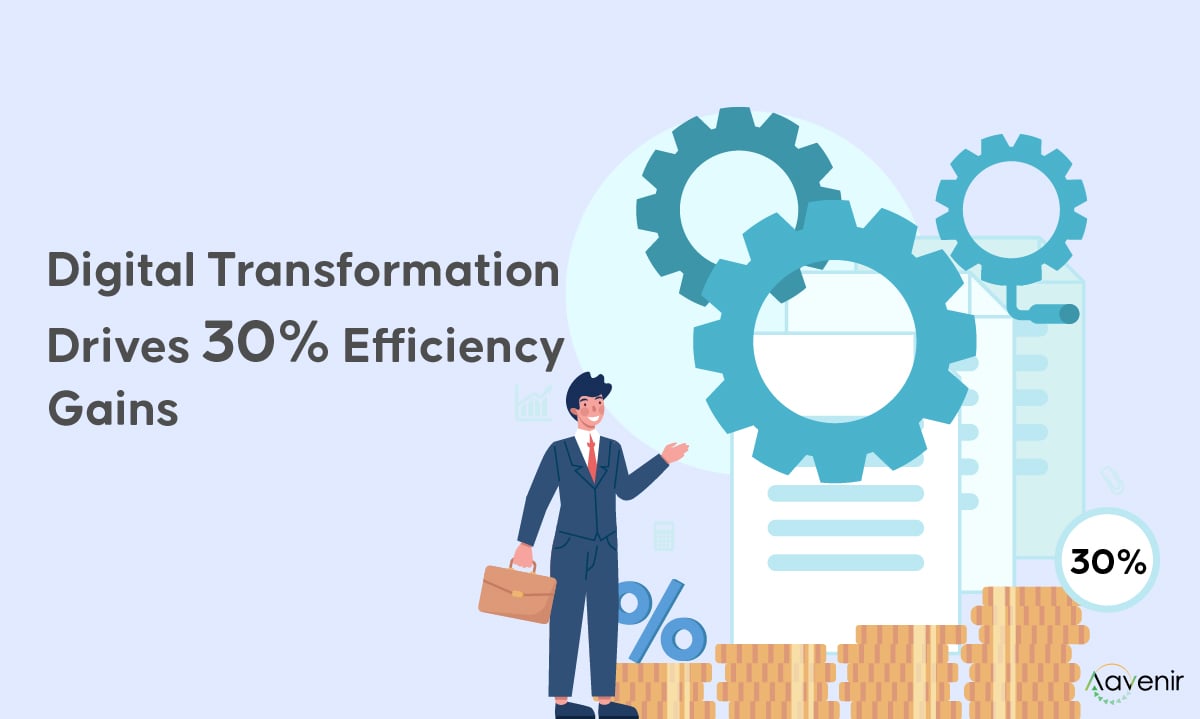
Solutions to Modern Procurement Challenges
Digital Tools for Real-Time Data and Decision-Making
According to McKinsey, companies that embrace digital solutions see up to 30% efficiency gains. Digital tools are transforming procurement by providing real-time data and actionable insights. Here’s how they can help:
- Data-Driven Decisions: AI and analytics can process vast amounts of data to provide insights that inform procurement decisions. For example, predictive analytics can forecast demand, identify trends, and suggest optimal purchasing times, helping procurement teams make informed decisions quickly.
- Process Automation: Automating routine tasks such as purchase order creation, invoice processing, and contract management can significantly improve efficiency. Robotic Process Automation (RPA) can handle repetitive tasks, freeing up procurement professionals to focus on strategic activities.
- Spend Visibility: Digital tools provide comprehensive visibility into spending patterns, enabling better budget management and cost control. Spend analysis software can categorize and analyze expenditures, helping identify areas for cost savings and efficiency improvements.
- Supplier Performance Management: Digital platforms can track and evaluate supplier performance in real time. This includes monitoring delivery times, goods quality, and contract terms compliance. For instance, supplier scorecards can provide a clear picture of supplier performance, facilitating better decision-making.
How to Strengthen Strategic Sourcing and Vendor Relationships
Building strong vendor relationships and implementing strategic sourcing practices are crucial for procurement success. Organizations can implement the following to strengthen strategic sourcing and vendor relationships:
- Resilient Supplier Networks: Developing a network of reliable suppliers can mitigate risks and ensure continuity. This involves identifying critical suppliers, conducting regular performance reviews, and maintaining open communication. For example, creating a supplier development program can help improve supplier capabilities and foster long-term partnerships.
- Cost Control: Strategic sourcing involves analyzing the total cost of ownership (TCO) rather than just the purchase price. This includes considering factors such as delivery costs, quality, and supplier reliability. By focusing on TCO, procurement teams can make more cost-effective decisions.
- Collaboration: Fostering collaboration with suppliers can drive innovation and efficiency. Joint initiatives such as co-development projects and shared risk management can lead to better outcomes. For instance, collaborating with suppliers on sustainability initiatives can help achieve environmental goals while reducing costs.
Key Sustainable Procurement Practices
Sustainability is becoming a key focus in procurement. Here’s how to integrate sustainable practices:
- Environmental Impact: Consider the environmental impact of procurement decisions. This includes evaluating the carbon footprint of suppliers, choosing eco-friendly materials, and reducing waste. For example, implementing a green procurement policy can help prioritize suppliers with strong environmental credentials.
- Sustainable Sourcing: Source materials and products from sustainable suppliers. This involves assessing suppliers’ sustainability practices and ensuring they meet environmental standards. For instance, using sustainability scorecards can help evaluate and select suppliers based on their environmental performance.
- Balance Goals: Balancing environmental goals with financial objectives is crucial. This can involve setting clear sustainability targets and integrating them into procurement strategies. For example, adopting circular economy principles can help reduce waste and improve resource efficiency, leading to cost savings and environmental benefits.
How Aavenir Can Help Overcome Procurement Challenges
Aavenir offers a suite of tools designed to enhance procurement efficiency. Key features include:
- Spend Visibility: Gain insights into spending patterns to identify savings opportunities. Aavenir’s spend analysis tools can categorize and analyze expenditures, helping procurement teams make data-driven decisions.
- Vendor Management: Streamline vendor management processes. Aavenir’s vendor management solutions can track supplier performance, manage contracts, and ensure compliance with regulatory requirements.
- Compliance Tracking: Ensure compliance with regulatory requirements through automated tracking. Aavenir’s compliance management tools can monitor regulatory changes and ensure that all procurement activities are compliant.
Signing off: Strengthening Procurement for the Future
In conclusion, procurement professionals must adopt adaptive, tech-driven strategies to navigate the procurement challenges of 2025.
Leveraging digital tools, building strong vendor relationships, and integrating sustainable practices can help procurement teams create value and drive efficiency across their organizations.
Are you a procurement professional facing an array of challenges, from managing costs and mitigating risks to driving digital transformation and sustainability. Reach out to our experts at Aavenir for a free consultation on how to align your procurement goals with broader business objectives.
Frequently Asked Questions (FAQs)
What are the challenges in direct procurement?
Direct procurement faces challenges such as managing supplier relationships, controlling costs, and optimizing inventory. Effective strategies to mitigate these issues include supplier performance tracking, predictive analytics, and strategic sourcing.
What are the challenges facing procurement officers?
Procurement officers face challenges like managing global supply chain disruptions, navigating compliance and regulatory issues, and addressing talent shortages. Staying proactive with digital tools and continuous learning helps tackle these challenges.
How does digital transformation impact procurement?
Digital transformation introduces AI, analytics, and automation into procurement, streamlining processes, improving decision-making, and enhancing supplier management. It ultimately drives efficiency and reduces risks.
Why is sustainability important in procurement?
Sustainable procurement practices reduce environmental impact, meet regulatory requirements, and appeal to stakeholders. Embracing sustainability can help build brand reputation and ensure long-term cost efficiency.
What role does risk management play in procurement?
Risk management helps procurement teams anticipate and mitigate disruptions, ensuring smoother operations and protecting the organization from costly delays or regulatory non-compliance.


